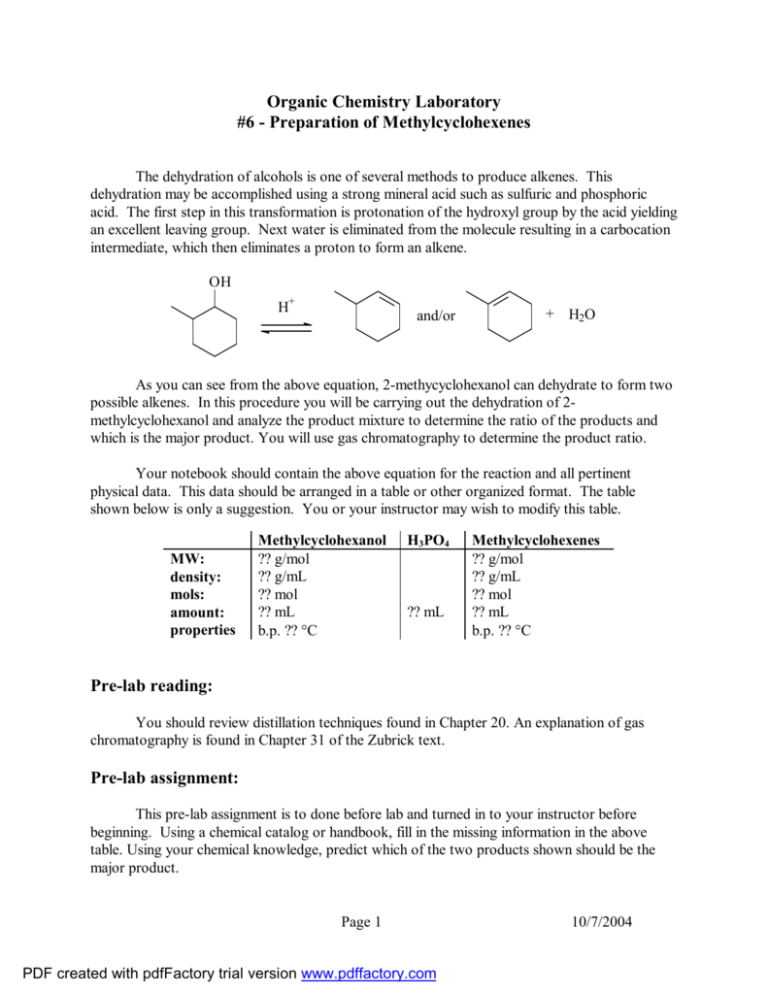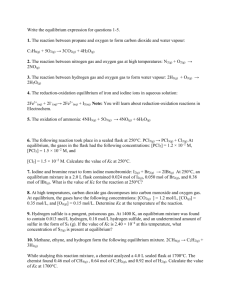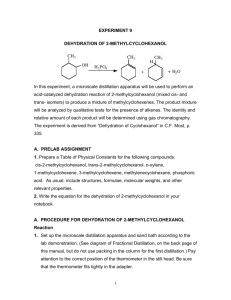Dehydration of Methylcyclohexenes
advertisement

Organic Chemistry Laboratory #6 - Preparation of Methylcyclohexenes The dehydration of alcohols is one of several methods to produce alkenes. This dehydration may be accomplished using a strong mineral acid such as sulfuric and phosphoric acid. The first step in this transformation is protonation of the hydroxyl group by the acid yielding an excellent leaving group. Next water is eliminated from the molecule resulting in a carbocation intermediate, which then eliminates a proton to form an alkene. OH H+ and/or + H2O As you can see from the above equation, 2-methycyclohexanol can dehydrate to form two possible alkenes. In this procedure you will be carrying out the dehydration of 2methylcyclohexanol and analyze the product mixture to determine the ratio of the products and which is the major product. You will use gas chromatography to determine the product ratio. Your notebook should contain the above equation for the reaction and all pertinent physical data. This data should be arranged in a table or other organized format. The table shown below is only a suggestion. You or your instructor may wish to modify this table. MW: density: mols: amount: properties Methylcyclohexanol ?? g/mol ?? g/mL ?? mol ?? mL b.p. ?? °C H3PO4 ?? mL Methylcyclohexenes ?? g/mol ?? g/mL ?? mol ?? mL b.p. ?? °C Pre-lab reading: You should review distillation techniques found in Chapter 20. An explanation of gas chromatography is found in Chapter 31 of the Zubrick text. Pre-lab assignment: This pre-lab assignment is to done before lab and turned in to your instructor before beginning. Using a chemical catalog or handbook, fill in the missing information in the above table. Using your chemical knowledge, predict which of the two products shown should be the major product. Page 1 PDF created with pdfFactory trial version www.pdffactory.com 10/7/2004 Procedure: Place 6.0 grams of 2-methylcyclohexanol into a 25 mL round-bottom flask. Carefully add 4 mL of 85% phosphoric acid, then a boiling stone and mount the flask on a ring stand. Caution: Phosphoric acid is very corrosive. Do not allow it to touch your skin. Fit the round bottom flask with three-way adapter, condenser, and thermometer (see fig. 98 on page 145). You may wish to collect the product in the 10 mL conical vial. Place an ice bath around the receiving flask. Slowly heat the reaction flask in a sand bath until it comes to a gentle boil. Maintain the gentle boil for 10 minutes, then increase the temperature to distill the product from the mixture. Do not let the distilling vapors exceed 95 °C. Continue distilling until 4 to 6 mL of distillate has been collected. Some water will have codistilled with the alkene and you will need to separate the product from the water. Do this using a pipet to transfer just the product to a clean dry test tube. Add some sodium sulfate and allow the product to dry for 10 minutes. Using a gas chromatograph or refractometer, analyze your mixture and determine the ratio of the products. Report: Submit a copy of your chromatogram and fill in the data report sheet. Questions: 1. How many stereoisomers can there be of 2-methylycyclohexanol? 2. In the gas chromatographic analysis of the product mixture of this reaction, a. How do you determine what peak corresponds to which compound? b. Does it matter whether you assume that the ratio of peak areas corresponds to the weight ratio or the mole ratio of the alkenes? c. How can you demonstrate that the ratio of peak areas is a valid measure of product composition? 3. In the analysis of the product mixture by refractive index, a. How can you determine the validity of the assumption of a linear relationship between molar composition and index of refraction? b. Would you expect a linear relationship between weight concentration and index of refraction? c. What assumption has been made about the number of components in the product mixture? Page 2 PDF created with pdfFactory trial version www.pdffactory.com 10/7/2004 Dehydration of 2-Methylcyclohexanol Data Report Sheet Name:__________________________ Section:_________________________ Date:___________________________ Retention time of 1-methylcyclohexene _____________________ Retention time of 3-methylcyclohexene _____________________ Area of 1-methylcyclohexene _____________________ Area of 3-methylcyclohexene _____________________ Percent of 1-methylcyclohexene _____________________ Percent of 3-methylcyclohexene _____________________ Refractive index of mixture _____________________ Percent of 1-methycyclohexene (by Rf) _____________________ Page 3 PDF created with pdfFactory trial version www.pdffactory.com 10/7/2004 Prelab: 2-Methylcyclohexanol Name:_____________________ Lab section:___________ Date:__________ 1. Using a chemical catalog or handbook, fill in the missing information in the table below. Show calculations for moles on back of page. Methylcyclohexanol H3PO4 1-Methylcyclohexene 3-Methylcyclohexene MW: g/mol g/mol g/mol density: g/mL g/mL g/mL mols: mol mol mol amount: mL mL mL properties 2. b.p. mL °C b.p. °C b.p. °C Using your chemical knowledge, predict which of the two products shown should be the major product. OH H+ and/or Page 4 PDF created with pdfFactory trial version www.pdffactory.com + H2O 10/7/2004 Extra Questions 1. Show the complete acid-catalyzed mechanism for the dehydration of 2-methylcyclohexanol. 2. What alkenes could be produced when each of the following alcohols is dehydrated: a. 2-methylcyclopentanol b. 3-methylcyclopentanol c. 2,3-dimethylbutanol 3. Draw the structures of all the alkenes with the formula C5H10. Provide the IUPAC name for each structure. 4. Which alcohol(s) would be the best to use to synthesize each of the alkenes drawn in question 3. 5. The 2-methylcyclohexanol used in this experiment is actually a mixture of two isomers. What are these two isomers? Does it make a difference in the product composition? Explain your answer. 6. Explain how the methylcyclohexene(s) can be distilled from the reaction mixture if the distillation temperature is kept below 95 °C? 7. Consider the IR spectra on the next page. Identify three peaks that are contained in one of the spectra and are not contained in the other. Page 5 PDF created with pdfFactory trial version www.pdffactory.com 10/7/2004 Page 6 PDF created with pdfFactory trial version www.pdffactory.com 10/7/2004







